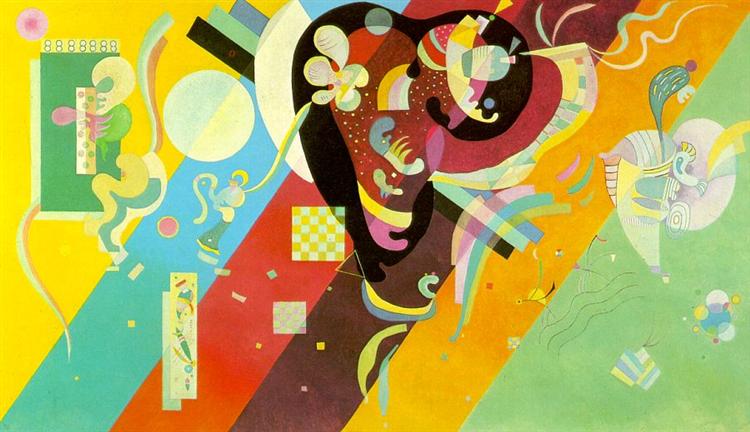Description
The "IX" composition "painting, created by Wassily Kandinsky, is one of the most emblematic works of the master of abstract art, whose artistic production was characterized by the exploration of the relationship between color and shape, sound and emotion. This painting, which is part of a series of compositions that Kandinsky made throughout his career, stands out not only for his visual complexity, but also for his deep symbolic and emotional burden.
The work is presented as an explosion of geometric and organic shapes, where the elements seem to flow and vibrate in a dynamic dance. The composition is asymmetric, which creates a sense of inherent movement; The figures seem to be in a constant state of transformation and dialogue. The circles, lines and colored spots interact with each other so that they evoke a visual symphony, a concept that Kandinsky always sought to materialize in his works, based on his theory about the correspondence between the visual and the sound.
The use of color in "composition IX" is particularly remarkable. Kandinsky uses a rich and varied palette that covers from warm to cold tones, achieving effects that transcend the merely aesthetic to activate deep emotions in the observer. Vibrant colors overlap and are in a contrast game that invites contemplation. This interaction of color can also be considered a reflection of the influence of psychological theories on color, which the artist was exploring in his time.
While in this work there are no clearly defined characters, it is important to note that the absence of concrete figures in the painting does not limit its evocation capacity. Instead, the work invites personal interpretation, where each spectator can find their own narrative in the controlled chaos of forms and colors. This approach is often associated with the idea of spirituality in art, a recurring theme in Kandinsky's work, which believed that painting could be a means to achieve transcendental experiences.
The context of "composition IX" creation is also relevant. During this time, Kandinsky had already been deeply influenced by his time in Bauhaus and his interaction with other contemporary thinking currents in Europe. The abstract painting had evolved and Kandinsky himself had consolidated his unique voice within this movement. In this sense, "composition IX" is not only a testimony of its technical and conceptual mastery, but also a reflection of a period of great political and social agitation in Europe, which in a way is insinuated in the complexity and multiplicity of senses of the work.
Through this composition, Kandinsky offers us not only a visual show, but also an invitation to an introspective trip where the viewer can miss and find himself. The "IX composition" is, therefore, a clear example of the culmination of the author's abstract style, which, through pure expression, seeks to connect the internal with the external, the emotional with the visual, and the spiritual with the tangible. This work, in its essence, is a dialogue between art and the spectator that transcends the mere observation to become a unique experiential experience.
KUADROS ©, a famous paint on your wall.
Hand-made oil painting reproductions, with the quality of professional artists and the distinctive seal of KUADROS ©.
Art reproduction service with satisfaction guarantee. If you are not completely satisfied with the replica of your painting, we refund your money 100%.

